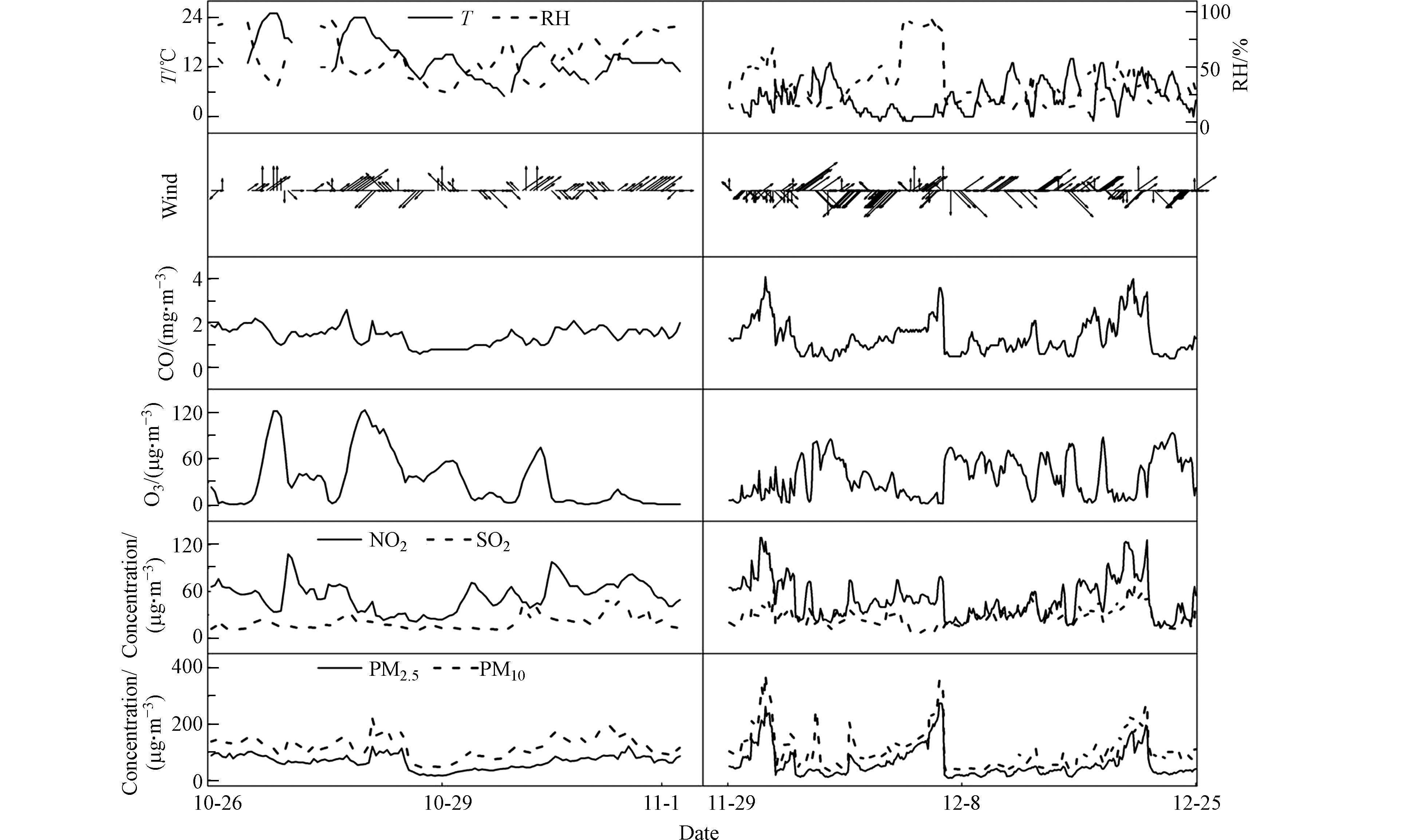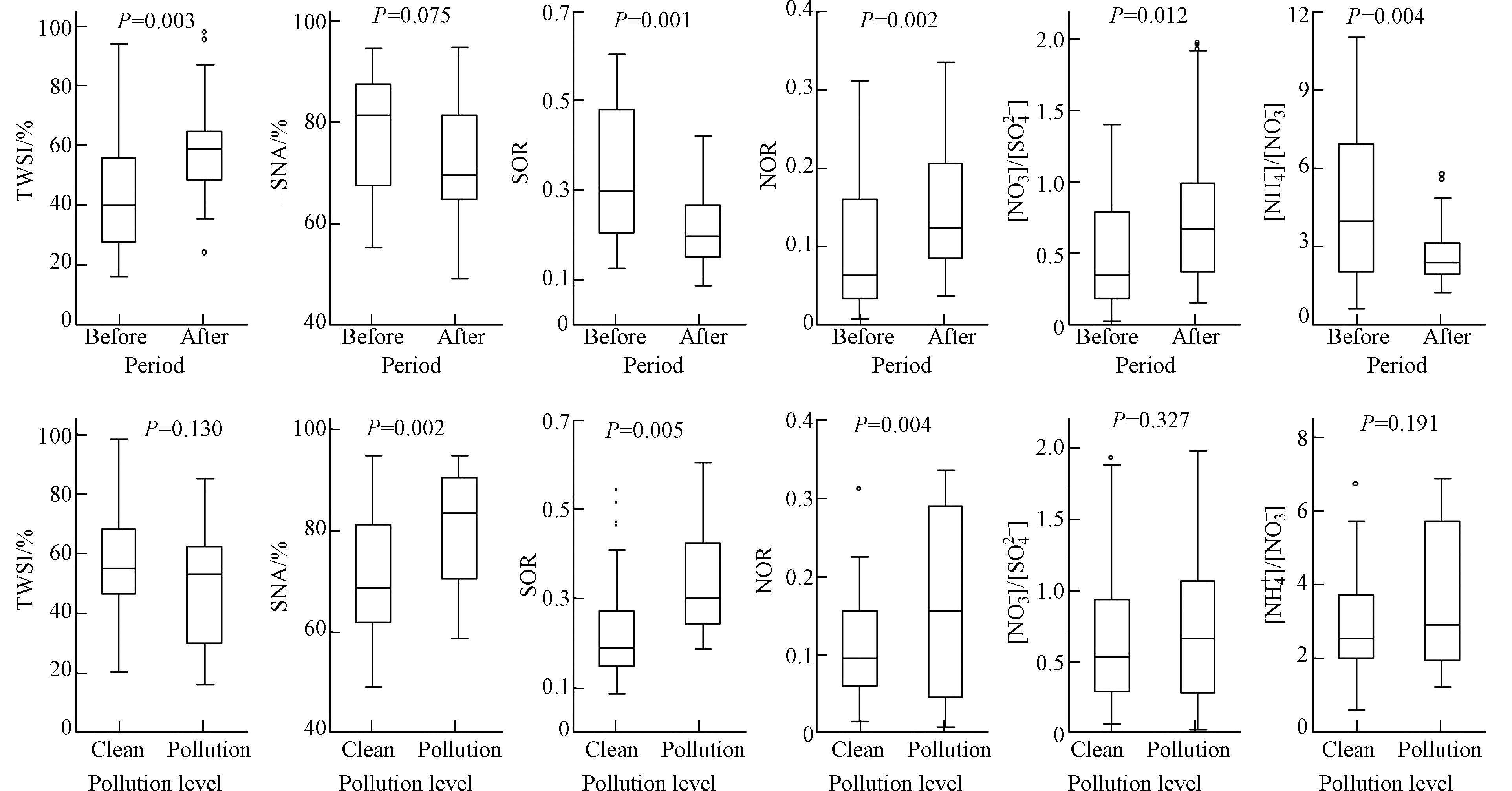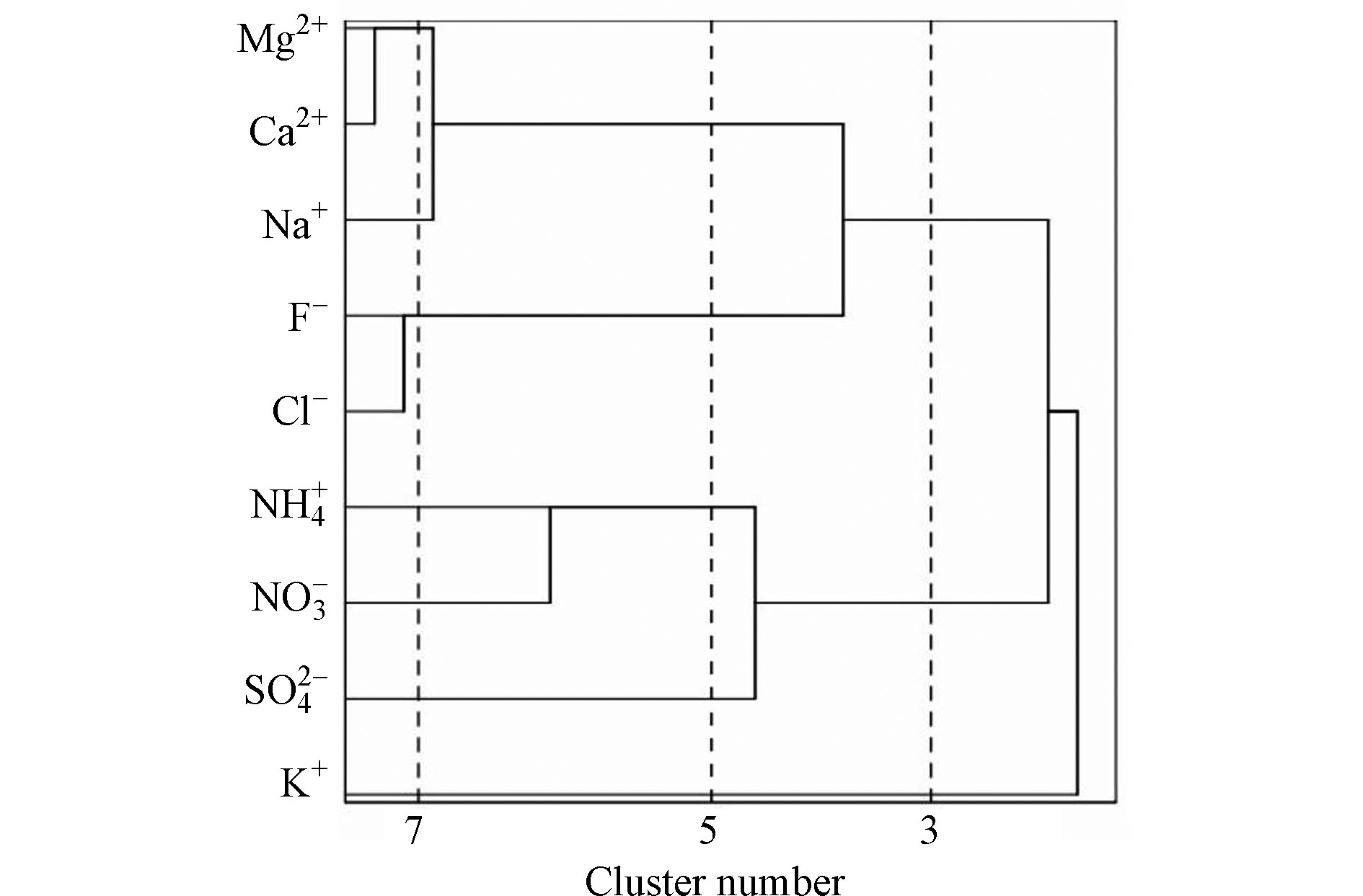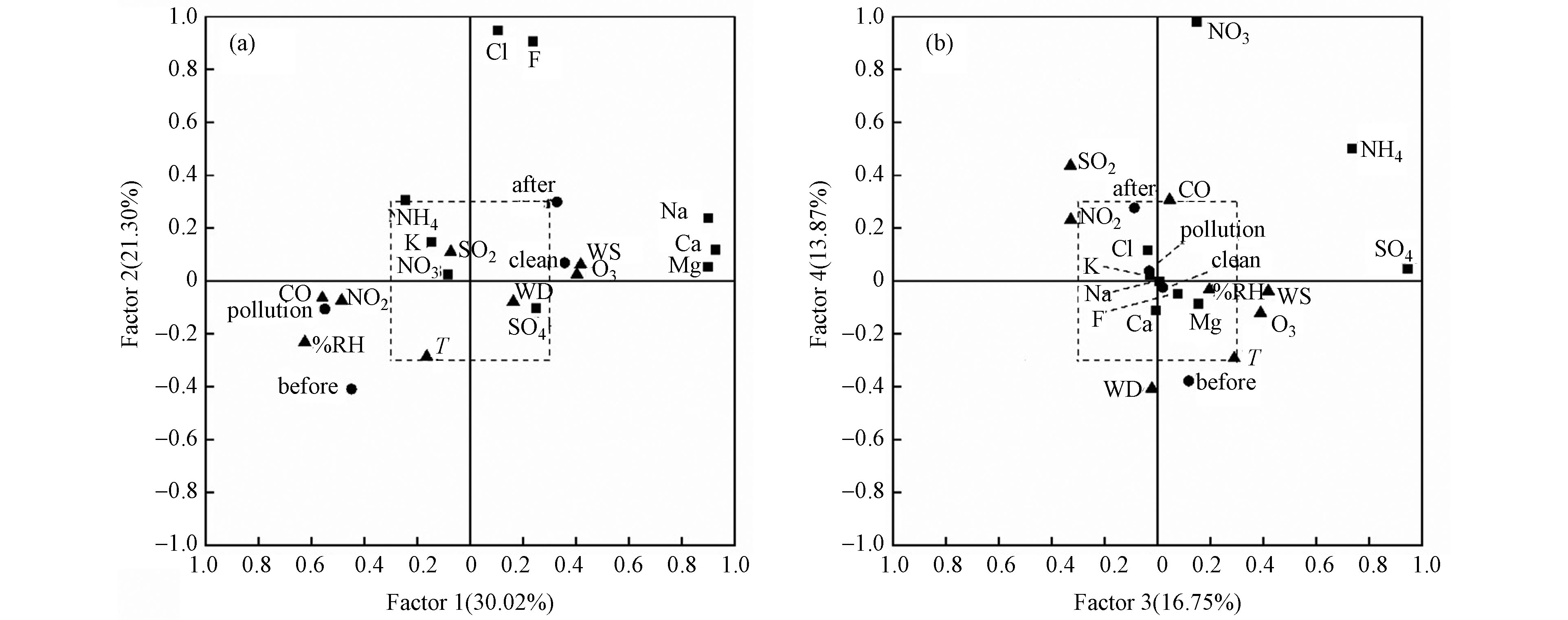-
自2013年以来,从中央到地方陆续颁布实施了一系列有关大气污染治理的环境政策,特别是2017年大气污染防治攻坚战以来,我国城市大气环境质量得以明显改善。与2015年相比,2019年我国337个地级以上城市中环境空气质量达标个数从73个增加到157个,平均优良天数比例从76.7%上升为82.0%,超标天数中以PM2.5和O3为首要污染物的天数占比分别从66.8%下降到45.0%和从16.9%上升到41.7%[1]。我国城市大气污染特征已由煤烟型污染转变成为以灰霾和臭氧污染为特征的复合型污染[2-3]。
冬季是我国北方城市灰霾高发的季节[4],不利的气象条件和燃煤供暖的增量排放使污染物更易积累,在区域传输和二次转化的叠加作用下,城区PM2.5浓度更易呈爆发式增长[5-6]。冬季易形成近地逆温层,大气混合层高度可被压缩至小于200 m,颗粒物中二次离子(
${\rm{NH}}_4^{+} $ 、${\rm{SO}}_4^{2-} $ 和${\rm{NO}}_3^{-} $ )大量生成,进而导致PM2.5浓度可迅速增加4—8倍[7-9]。冬季较低的相对湿度与温度导致${\rm{SO}}_4^{2-} $ 转化率降低和NO3−稳定性增加[10-12];冬季降水次数减少和林木对${\rm{NH}}_4^{+} $ 吸收能力减弱,城市大气呈现富${\rm{NH}}_4^{+} $ 特征[13-14];冬季大风天气携带扬尘,导致Ca2+和Mg2+浓度增加[5];冬季采暖期燃煤量增加,引起K+和Cl−浓度可增加一个数量级[15]。面对冬季诸多不利因素,需要实施更为精准的环境政策以应对不同时段灰霾污染来源的差异性。焦作市属于“2+26”京津冀大气污染传输通道城市。与2015年相比,2018年焦作市SO2、NO2、PM2.5浓度分别下降63.3%、18.0%、23.0%[16],大气环境质量得到一定改善,但2018、2019年连续两年环境空气质量仍位于全国337个地级以上城市中倒数前20,PM2.5仍是秋冬两季大气环境的首要污染物[1]。焦作市冬季污染天二次离子在PM2.5中的占比显著增加[17],PM2.5污染来源以本地源为主,沿太行山南麓的区域输送也有一定贡献[18]。前人研究多集中于城市灰霾污染的特征和来源,而将其与当地实施的大气环境政策进行关联却鲜有研究。本文以2017年冬季供暖日前/后采集的两段PM2.5样品为对象,对比分析了不同时段水溶性离子特征和污染来源的差异性,结合焦作市2017年实施的大气污染治理的环境政策,以期为冬季城市灰霾污染的针对性管控提供科学的决策依据。
-
焦作市地处太行山南麓,总体地势平坦,地面坡度小于0.5°,近5年(2016—2020年)10—12月份平均近地层主导风向为东北风(图1,数据来源http://www.91weitu.com和http://lishi.tianqi.com),太行山山前地势和气象风场不利于城市大气污染物扩散[19],且城市一次能源结构中煤炭占比超过90%[20],城区周边工业布局不合理加重了焦作市大气污染程度[21]。
-
《“2+26”城市大气污染综合治理方案》焦作课题组于10月26日—11月1日在焦作市高新区行政楼楼顶(35°10′54″ N, 113°14′46″ E)采集PM2.5,采样周期4—6 h,共采集30个样品,此段样品定义为供暖日前。焦作市2017年11月15日开始供暖。河南理工大学大学生科创计划课题组于11月29日—12月25日在本校资源环境学院楼顶(35°11′13″ N, 113°15′16″ E)采集PM2.5,采样周期12—24 h,共采集41个样品,此段样品定义为供暖日后。两个采样点临近交通干道迎宾路和世纪路,直线距离1000 m,采样仪器距地面15—18 m,周围无高大建筑物遮挡,两采样点污染物来源可视为无差异。采样期间以《环境空气质量标准》(GB 3095—2012)规定的PM2.5浓度限值二级标准为界,≤ 75 μg·m−3为清洁时段样品,> 75 μg·m−3为污染时段样品,供暖日前/后清洁时段样品数分别为16、27个,污染时段样品数分别为14、14个。
大气颗粒物监测方法依照《环境空气总悬浮颗粒物的测定-重量法》(GB/T15432—1995) (2018修订)执行。大气综合采样器(科迪博KDB-120型)为中流量(1.05 m3·min−1),滤膜为聚四氟乙烯材质,分别为直径90 mm的圆形滤膜和20—74 mm的环形滤膜,通过切割器分别采集PM2.5和PM10的颗粒物样品。滤膜采样前/后的重量使用微量电子天平(梅特勒MS105DU型,0.00001 g精度)称量。水溶性离子萃取方法为:将1/4滤膜和25 mL超纯水(18.25 MΩ·cm)于50 mL塑料离心管中,180 r·min−1、25 ℃机械振荡30 min,超声振荡30 min后通过0.45 μm微孔滤膜过滤,冰箱4 ℃冷藏保存。离子浓度采用离子色谱仪(戴安IC-3000型)分析,阴离子(F−、Cl−、
${\rm{SO}}_4^{2-} $ 、${\rm{NO}}_3^{-} $ )和阳离子(Na+、${\rm{NH}}_4^{+} $ 、K+、Mg2+、Ca2+)的淋洗液分别为25 mmol·L−1 NaOH溶液和25 mmol·L−1甲磺酸溶液,淋洗液流速1.0 mL·min−1,柱温35 ℃。配制混标溶液用标准曲线法对样品中各离子浓度进行校准,每50次测试校准1次,测试结果用空白滤膜做空白实验校正。 -
离子浓度通过累积标况体积转化为大气颗粒物浓度(μg·m−3)。离子比值包括:总水溶性离子占比TWSI%(the mass ratio of TWSI to PM2.5)表示水溶性离子对PM2.5污染的贡献值;二次离子占比SNA%(the mass ratio of SNA to TWSI)表示二次离子
${\rm{NH}}_4^{+} $ 、${\rm{SO}}_4^{2-} $ 和${\rm{NO}}_3^{-} $ 对水溶性离子的贡献值[9];SOR(the sulfur oxidation ratio)和NOR(the nitrogen oxidation ratio)分别表示气态污染物SO2、NO2向${\rm{SO}}_4^{2-} $ 、${\rm{NO}}_3^{-} $ 转化的程度[10];硝硫物质的量比([${\rm{NO}}_3^{-} $ ]/[${\rm{SO}}_4^{2-} $ ])可以判定固定污染源和移动污染源贡献值的相对大小,大于1.0以移动污染源为主,反之以固定污染源为主[22-23];铵硝物质的量比([${\rm{NH}}_4^{+} $ ]/[${\rm{NO}}_3^{-} $ ])反映大气颗粒物中还原态氮与氧化态氮的比例;阴阳离子物质的量比([CE]/[AE])能够反映大气颗粒物的酸碱性,大于1.0呈碱性,反之呈酸性[24]。采样期间的焦作市城区大气污染物浓度和气象因素数据来源于空气质量在线监测分析平台(https://www.aqistudy.cn),具体见图2。
采用SPSS软件的一般线性模型(GLM)中单变量-主效应模型对水溶性离子浓度、离子比值和其它因素在供暖日前/后和清洁/污染时段下进行差异性检验。其他因素包括气态污染物(CO、O3、SO2、NO2)浓度和气象因素(温度(T)、湿度(RH)、风向(WD)、风速(WS)、风向(WD),风向WD仅表示风的来向,N=0°,顺时针增加)。
采用SPSS中的系统聚类和因子分析工具对水溶性离子进行污染来源解析。系统聚类首先将离子浓度通过颗粒物浓度转化为离子质量分数,进行Z得分标准化转换后,再按变量分群,采用组间联接的聚类方法处理。因子分析使用基于特征值大于1.0进行主成分抽取,最大方差法旋转后的因子荷载矩阵进行成份判定,以旋转平方和载入的方差百分比得出因子贡献值。
-
如表1所示,水溶性离子浓度大小顺序为:
${\rm{SO}}_4^{2-} $ >${\rm{NO}}_3^{-} $ >${\rm{NH}}_4^{+} $ > Ca2+ > Cl− > K+ > Na+ > F− > Mg2+。各离子浓度的数据均表现为强变异性、正偏态分布和过度峰度。与其它研究比较(表2),本研究采样期间PM2.5中水溶性离子浓度表现出典型的煤烟型污染特点:
${\rm{SO}}_4^{2-} $ 、Ca2+和Cl−离子占比相对较大,区别于${\rm{NO}}_3^{-} $ 和${\rm{NH}}_4^{+} $ 离子占比相对较大的尾气型污染。${\rm{NH}}_4^{+} $ 离子浓度较北京和成都偏大,较其他城市偏小;${\rm{SO}}_4^{2-} $ 离子浓度与成都、邯郸、郑州[10]、太原和北京相近,较焦作[18]和郑州[8]偏小;${\rm{NO}}_3^{-} $ 离子浓度与成都、邯郸和太原接近,较其他城市均明显偏小;Ca2+离子浓度与同期焦作[17]接近,较太原、北京偏小;Cl−离子浓度与成都接近,较其他城市偏小。 -
如表3所示,供暖日后PM2.5中总水溶性离子浓度(TWSI)、Na+、Ca2+、Cl−、
${\rm{NO}}_3^{-} $ 浓度和${\rm{NH}}_4^{+} $ 、K+浓度在供暖日前/后时段之间均存在显著差异,分别达到P<0.01和P<0.05水平,Mg2+、F−和${\rm{SO}}_4^{2-} $ 浓度均未达到差异的显著水平。相较于供暖日前,供暖日后TWSI由30.24 μg·m−3显著上升为44.39 μg·m−3。Cl−(+307.5%)上升幅度最大,其次是NO3−(+104.5%),TWSI和Na+、Ca2+、NH4+浓度上升幅度范围为34.7%—52.3%,与之相反,K+浓度却显著下降35.2%。由图2和其他因素在供暖日前/后的差异性分析可知(表略),相较于供暖日前,供暖日后SO2浓度显著(P<0.05)上升,温度、湿度均显著(P<0.01)下降。在一定程度上反映了城市燃煤供暖引起大气污染物排放增量,叠加冬季逆温对城市大气扩散程度的降低效应是导致颗粒物中水溶性离子浓度(尤其是Cl−)显著升高的主要原因[4, 29]。在清洁/污染时段之间,除Ca2+、F−浓度外,PM2.5中其他水溶性离子浓度均存在极显著差异(P <0.01)。相较于清洁时段,污染时段二次离子浓度的上升幅度(156.3%—201.2%)明显大于一次离子浓度的上升幅度(44.0%—110.9%)。由其他因素在清洁/污染时段的差异性分析可知(表略),相较于清洁时段,污染时段PM2.5、PM10、CO、NO2(P<0.01)浓度和温度、湿度(P<0.05)均显著增加,风速和O3浓度却显著(P<0.01)降低。由此反映了气态污染物二次反应程度增加是污染时段水溶性离子浓度增加的主要原因[9, 25]。
-
如图3所示,供暖日前/后PM2.5中TWSI%(P<0.01)、SOR(P<0.01)、NOR(P<0.01)、[
${\rm{NO}}_3^{-} $ ]/[${\rm{SO}}_4^{2-} $ ](P<0.05)和 [${\rm{NH}}_4^{+} $ ]/[${\rm{NO}}_3^{-} $ ](P<0.01)均存在显著差异,SNA%和[CE]/[AE](图略)未达到差异的显著水平。清洁/污染时段PM2.5中SNA%、SOR和NOR存在显著(P<0.01)差异,其他离子比值均未达到差异的显著水平。TWSI%由供暖日前的45.0%极显著上升为供暖日后的59.5%,表明城市供暖可显著增加水溶性离子对PM2.5污染的贡献。TWSI%的大小受多种因素影响,颗粒物的老化程度是一个重要因素[27]。悬浮的大气颗粒物受酸性气体溶解刻蚀作用越大,水溶性离子占比会越大。供暖日后的12月份,降雨次数偏少,平均湿度要低于供暖日前,颗粒物老化程度增大是供暖日后TWSI%显著增加的一个主要原因。潘湘龙和王刘铭[17-18]在焦作以2018年1月份样品为主,TWSI%较本研究偏高。
SNA%由清洁时段的70.1%极显著上升为污染时段的80.0%,表明污染时段SNA对TWSI的贡献显著增加。重污染时段SNA的快速增加,也会引起TWSI%的显著升高,如郑州冬季时段[8]。在小风或静风不利扩散条件下,SNA%与TWSI%同步增加;而在有风条件下,颗粒物中钙镁总量的快速增加导致SNA%变化与TWSI%变化不同步。
SOR由供暖日前的0.34极显著下降为供暖日后的0.22,NOR则由供暖日前的0.10极显著上升为供暖日后的0.16。SOR和NOR受大气温度、湿度和气态污染物SO2和NO2浓度的共同影响[30]。冬季低温干燥的环境可导致
${\rm{SO}}_4^{2-} $ 转化率降低和${\rm{NO}}_3^{-} $ 稳定性增加[10-12]。此外,SOR、NOR分别由清洁时段的0.24、0.11极显著上升为污染时段的0.34、0.16。相对清洁时段,污染时段下温度和湿度均显著上升促进了酸性气体在颗粒物表面上非均相反应的进度和限度,且当RH>50%时,${\rm{SO}}_4^{2-} $ 和${\rm{NO}}_3^{-} $ 主要以液相和非均相反应生成[31],近地面层1.0—2.5 μm的液相晶核大量生成[32],进一步导致二次污染程度的增加。[
${\rm{NO}}_3^{-} $ ]/[${\rm{SO}}_4^{2-} $ ]由供暖日前的0.51显著上升为供暖日后的0.80,均小于1.0,表明焦作市PM2.5以固定污染源为主。供暖日后硝硫比显著升高主要受NOR增加和SOR降低的共同影响[10]。潘湘龙和王刘铭[17-18]在焦作以2018年1月份样品为主,气温更低,硝硫比较本研究偏高(表2)。相对清洁时段,污染时段的NOR和SOR均显著增加,但${\rm{NO}}_3^{-} $ 和${\rm{SO}}_4^{2-} $ 的增幅具有不确定性,硝硫比表现为无显著差异。[
${\rm{NH}}_4^{+} $ ]/[${\rm{NO}}_3^{-} $ ]由供暖日前的8.09极显著下降为供暖日后的2.68,均大于1.0,表明焦作市PM2.5中氮以还原态为主,供暖期间[${\rm{NH}}_4^{+} $ ]/[${\rm{NO}}_3^{-} $ ]的变异性明显减小,表明此期间氧化/还原态氮的来源较为一致。大多数研究城区的颗粒物铵硝摩尔比范围为1.8—2.9,交通源是城区还原态铵的主要来源[13],工业燃烧和机动车尾气排放是氧化态硝的重要来源。本研究供暖日前的铵硝比为8.1,${\rm{NH}}_4^{+} $ 的增加受农业源的影响较大[33]。受树叶对氨吸收的影响,灌木林区该比值降为0.7—1.5[13],与北京[28]采样点的周围情况较为一致(表2)。[CE]/[AE]平均为(1.74±0.54),表明焦作市供暖日前/后PM2.5整体呈碱性,污染时段较清洁时段有一定降低趋势(0.1<P<0.05),表明污染时段PM2.5的酸性略有增强。表2中北方城市在冬季[CE]/[AE]多大于1.0,颗粒物呈碱性,成都[27]的[CE]/[AE]小于1.0,颗粒物呈酸性。在污染时段,阴离子中
${\rm{SO}}_4^{2-} $ 离子浓度的升高可引起颗粒物酸性的显著增强[34]。 -
采用离子浓度进行主成分分析,由于缺乏离子浓度与颗粒物浓度之间的因果联系,第一因子通常为燃煤和二次离子的复合源[30, 34-35],对污染来源的判定不尽合理,难以对污染源的有效管控提供依据。因此本研究以离子在颗粒物中的质量分数进行聚类分析和主成分分析。
当聚类数分别为3、5和7时,聚类分析如图4所示。当聚类数为5时,聚类分析的分类结果与主成分分析结果基本一致,可分为因子1(Na+、Mg2+、Ca2+)、因子2(F−、Cl−)、因子3(
${\rm{SO}}_4^{2-} $ 、${\rm{NH}}_4^{+} $ )、因子4(${\rm{NO}}_3^{-} $ 、${\rm{NH}}_4^{+} $ )和因子5(K+),根据旋转后因子荷载值,5个因子累计解释水溶性离子污染来源的93.61%,贡献值分别为30.02%、21.30%、16.75%、13.87%和11.85%。根据各离子在因子轴上的位置(图5)可解释其对因子的贡献程度。Ca2+、Na+和Mg2+离子之间的相关性较高,焦作地处内陆,颗粒物中Na+受海源的影响较小,因子1可判定为自然扬尘源[29]。Cl−、F−离子间的相关性较高,由于缺乏其针对性的污染排放标准,两离子可反映燃煤燃烧相对量的大小,因子2可判定为燃煤源[25]。
${\rm{SO}}_4^{2-} $ 离子主要来自固定污染源的贡献[36],在载荷图上${\rm{NH}}_4^{+} $ 离子也位于第一象限(图5(b)),且与${\rm{SO}}_4^{2-} $ 离子存在一定的相关性(与原点连线的夹角小于45°),因子3可判定为工业排放源,反映当地的工业废气治理水平。${\rm{NO}}_3^{-} $ 离子来自汽车尾气和工业排放氮氧化物的光化学反应,其与${\rm{NH}}_4^{+} $ 离子也存在一定的相关性(与原点连线的夹角为45°—90°),考虑到聚类分析结果将${\rm{NH}}_4^{+} $ 和${\rm{NO}}_3^{-} $ 归为一类,以及${\rm{NH}}_4^{+} $ 优先与SO42-结合,后与${\rm{NO}}_3^{-} $ 结合的特点[10],将因子4判定为机动车尾气源[37]。因子5中K+荷载较大(图略),判定为生物质燃烧源[38]。 -
对污染源因子得分与其它因素进行双变量皮尔逊相关分析,以双侧检验结果进行显著性判定,将相关性值映射在主成分分析的载荷图上表示污染源与其它因素的相关性。如图4所示,在极显著水平(P<0.01)上,自然扬尘源(因子1)与O3浓度、风速正相关,与CO、NO2浓度、湿度负相关;工业排放源(因子3)与O3、风速正相关,与NO2、SO2负相关;机动车尾气源(因子4)与CO、SO2正相关,与风向负相关。在显著水平(P<0.05)上,温度与工业排放源(因子3)正相关,与燃煤源(因子2)和机动车尾气源(因子4)负相关。生物质燃烧源(因子5)与其它因素的相关性均未达到显著性水平。
-
主成分分析的因子得分值大小能够反映出污染源的相对重要性。对污染源因子得分在供暖日前/后和清洁/污染时段下进行描述统计和差异性检验,将统计结果映射在主成分分析的因子载荷图上来表示污染源分时段的相对重要性大小。如图4所示,相较于供暖日前(before),供暖日后(after)因子1、2和4的因子得分显著增加;因子3无明显变化;因子5显著降低(图略)。供暖日前污染源的相对重要性从大到小依次为:生物质燃烧源>工业排放源>机动车尾气源≈燃煤源≈自然扬尘源;供暖日后:自然扬尘源≈燃煤源≈机动车尾气源>工业排放源>生物质燃烧源。
相较于清洁时段,污染时段因子1和5的因子得分显著降低,因子2、3、4却变化不明显。清洁时段污染源的相对重要性从大到小依次为:自然扬尘源>生物质燃烧源>燃煤源≈工业排放源≈机动车尾气源,污染时段:机动车尾气源≈工业排放源≈燃煤源>生物质燃烧源>自然扬尘源。
-
焦作市人民政府在2017年相继发布了20篇涉大气污染防治的环境政策,管控措施涉及范围广,但缺乏针对不同污染来源,特别是不同时段下的有效管控措施。
综合不同时段因子得分的变化,得到污染源重要性的决策矩阵,如表4所示。由表4可知,生物质燃烧源是供暖日前清洁时段的主要污染来源. 本研究中,尽管供暖日前处于秸秆严格禁烧期,K+离子浓度仍在 10 月 30—31 日显著升高,这主要受周围着火点分布的影响[39] . 以 2016 年同期为参照,采样点周围火点主要集中在山西南部和洛阳南部的山区地形,华北平原分布偏少[39] . 由图 2 可知,该时段以西南风为主,区域传输对采样点生物质燃烧源应有较大贡献.
自然扬尘源是供暖日后清洁时段应首要控制的污染源。本研究中,自然扬尘源与O3浓度、风速正相关,与CO、NO2浓度、湿度负相关。扬尘来源可分为土壤尘、道路扬尘、施工扬尘和工业固料堆场扬尘[40]。市区周边工业园区堆存的工业固料和市区北山历史堆存的工业废料应对扬尘源有较大贡献(图1)。O3浓度峰值多出现天气晴朗的午后时段[41]。因此,针对扬尘源的有效管控,建议在午后以及空气清洁时段,加强道路湿除尘,定期利用高压雾炮车对行道树和高层建筑进行清洗,同时在有风时段加强市区周边工业固料堆场的覆盖降尘管理。
工业排放源是供暖日前污染时段的主要污染来源。2017年3月至2018年9月,焦作市对辖区内(热)电厂进行超低排放改造。改造后的2018年全市二氧化硫和工业烟尘排放量分别为7428 t和3985 t,分别较改造前的2016年降低45%和75%[20]。本研究中,工业排放源与O3、风速和温度正相关,与NO2、SO2负相关。大气中强氧化剂O3可促进SO2氧化形成SO3进而形成硫酸盐[12],供暖日前较高的温度和湿度有利于SO2非均相化学氧化反应的进行,SO42-转化程度偏高(图3)。因此,工业排放源的管控除排放量削减外,对前驱物O3的控制和在有风污染时段对企业削峰生产也至关重要。
燃煤源是供暖日后污染时段主要污染来源。2017年10月份是焦作市对燃煤管控最为严格的时期,中小型企业和农村散煤大多关停进行“煤改气”整改,工业和生活消耗燃煤量达到历史极低值;12月份由于城市供暖、以及中小型企业部分复产和农村散煤恢复,燃煤源的比重增加。这也解释了供暖日前Cl−离子浓度(0.53 μg·m−3)较其它研究偏小的原因;供暖日后Cl−离子浓度上升幅度(+307.5%)在所有离子中最大,体现了12月份燃煤管控减弱的结果。本研究中,燃煤源与其它因素的相关性较差。针对燃煤源的有效管控,应对区域内在污染时段执行限产或停产的燃煤单位进行执法监督。
机动车尾气源也是供暖日后污染时段主要的污染来源。2018年焦作市小型汽车总量为45万辆[20],较表2中的城市均偏小,且主城区远离我国南北干线京广线,受机动车尾气源影响较北京、郑州、邯郸等城市偏小。2017年12月4—31日,焦作主城区实行机动车单双号限行和划定高排放非道路移动机械禁用区,对采样期间机动车尾气源重要性有一定的降低作用,然而要达到显著降低,机动车需限行比例需达到70%[42]。本研究中,机动车尾气源与CO、SO2正相关,与风向、温度负相关。汽车燃料的不完全燃烧是CO的直接来源[43]。东北风时段下机动车尾气源贡献显著升高,此方向上风向的山阳区循环经济产业聚集区和马村区万方工业园区的工业排放对采样点机动车尾气源有一定贡献。因此,在NE方向来风(图1的主导风向)的污染时段,加强其上风向的道路限行、划定禁用区和工业园区限产等措施,将对采样点机动车尾气源起到有效管控。
-
对焦作市2017年供暖日前/后和清洁/污染时段的PM2.5水溶性离子的浓度和比值进行差异性分析,并利用聚类和因子分析、相关性和决策矩阵等工具分析了PM2.5污染来源。相较于供暖日前,供暖日后Cl−、
${\rm{NO}}_3^{-} $ 、TWSI、Na+、Ca2+、${\rm{NH}}_4^{+} $ 浓度,TWSI%、NOR和[${\rm{NO}}_3^{-} $ ]/[${\rm{SO}}_4^{2-} $ ]均显著上升;K+浓度、SOR和[${\rm{NH}}_4^{+} $ ]/[${\rm{NO}}_3^{-} $ ]却显著下降。相较于清洁时段,污染时段二次离子浓度的上升幅度(156.3%—201.2%)明显大于一次离子浓度的上升幅度(44.0%—110.9%),SNA%、SOR和NOR均显著上升。采样期间PM2.5污染来源解析为:自然扬尘源(30.02%)>燃煤源(21.30%)>工业排放源(16.75%)>机动车尾气源(13.87%)>生物质燃烧源(11.85%)。自然扬尘源、燃煤源和机动车尾气源的重要性在供暖日后显著增加;自然扬尘源和生物质燃烧的重要性在污染时段显著降低。污染源与其它因素相关性分析和决策矩阵分析的结果表明,在不同时段采取针对性的环境政策将有利于冬季城市PM2.5污染的有效管控。
冬季供暖对城市大气PM2.5水溶性组成及污染源解析的影响
Impacts of municipal heat supply in winter on water-soluble ions and sources identification of atmospheric PM2.5
-
摘要: 在雾霾高发的冬季,针对污染来源的差异精准实施不同环境政策对城市大气污染治理具有重要的现实意义。以焦作市为例,于2017年市政供暖日(11月15日)前/后分2批采集大气PM2.5样品,对比分析了供暖日前/后PM2.5中水溶性离子组成及其污染来源的差异性,并对清洁/污染时段下雾霾治理环境政策的实施做出针对性建议。结果表明,相较于供暖日前,供暖日后总水溶性离子浓度显著上升(30.24 μg·m−3→44.39 μg·m−3),其中Cl−(+307.5%),
${{\rm{NO}}_3^{-}} $ (+104.5%),Na+、Ca2+和${{\rm{NH}}_4^{+} }$ (+34.7%—+52.3%),颗粒物中水溶性离子占比(45.0%→59.5%)、氮氧化率(0.10→0.16)和硝硫物质的量比(0.51→0.80)均显著上升,而K+(−35.2%)、硫氧化率(0.34→0.22)和铵硝物质的量比(8.09→2.68)却显著下降。相较于清洁时段,污染时段二次离子(${{\rm{NH}}_4^{+} }$ 、${{\rm{SO}}_4^{2-} }$ 和${{\rm{NO}}_3^{-}} $ )浓度的上升幅度(156.3%—201.2%)明显大于一次离子浓度的上升幅度(44.0%—110.9%),水溶性离子中二次离子占比(70.1%→80.0%)、硫氧化率(0.24→0.34)和氮氧化率(0.11→0.16)均显著上升。聚类和因子分析结果表明,采样期间PM2.5污染来源分别为:自然扬尘源(30.02%)>燃煤源(21.30%)>工业排放源(16.75%)>机动车尾气源(13.87%)>生物质燃烧源(11.85%)。自然扬尘源、燃煤源和机动车尾气源的重要性在供暖日后显著增加;自然扬尘源和生物质燃烧的重要性在污染时段显著降低。针对不同污染来源的时段差异性,提出了冬季城市PM2.5污染有效管控的差异化环境政策。Abstract: Precise implementation of different environmental policies according to pollution sources is critical for urban air pollution control in winter, when haze occurs frequently. We collected two batches of PM2.5 samples in Jiaozuo City before and during the heating season (HS) in 2017. Differences in the composition of water-soluble ions and sources composition of PM2.5 samples were investigated. Corresponding suggestions on the implementation of environmental policies for haze control were also provided. It was found that the mass concentrations of total water-soluble ions (TWSI) of PM2.5 during the HS increased significantly than that before the HS (30.24 μg·m−3→44.39 μg·m−3), including Cl− (+307.5%),${\rm{NO}}_3^{-} $ (+104.5%), Na+, Ca2+, and${\rm{NH}}_4^{+} $ (+34.7%—+52.3%), the mass ratio of TWSI to PM2.5 (45.0%→59.5%), the nitrogen oxidation ratio (NOR) (0.10→0.16) and the molar ratio of${\rm{NO}}_3^{-} $ to${\rm{SO}}_4^{2-} $ (0.51→0.80). However, the opposite was true for K+ (−35.2%), the sulfur oxidation ratio (SOR) (0.34→0.22) and the molar ratio of${\rm{NH}}_4^{+} $ to${\rm{NO}}_3^{-} $ (8.09→2.68). The increments of the total mass concentration of sulphate, nitrite, and ammonium (SNA) (156.3%—201.2%) during the pollution period were significantly higher than those of primary ions (44.0%—110.9%). In addition, the mass ratio of SNA to TWSI (70.1%→80.0%), SOR (0.24→0.34) and NOR (0.11→0.16) during the pollution period increased significantly than that during the clean period. Pollution sources of PM2.5 during the sampling periods were identified by clustering analysis and factor analysis as follows: natural dust source (30.02%) > coal burning source (21.30%) > industrial emission source (16.75%) > motor vehicle exhaust source (13.87%) > biomass combustion source (11.85%). During the HS, the contributions of natural dust sources, coal sources and motor vehicle exhaust sources to PM2.5 increased significantly in comparison to those before HS. During the pollution period, the contributions of natural dust sources and biomass combustion sources decreased significantly when compared with those during clean period. Corresponding to the temporal difference in pollution sources, we proposed differentiated environmental policies to effectively control PM2.5 pollution in winter. -

-
表 1 焦作市2017年采样期间水溶性离子浓度统计描述(μg·m−3)
Table 1. Description statistics of water-soluble ions concentrations during sampling periods of 2017 in Jiaozuo
项目
Project均值
Mean标准偏差
SD中位数
Median10%位数
10%digits90%位数
90%digits偏度
Skewness峰度
KurtosisNa+ 0.79 0.53 0.63 0.20 1.48 1.42 3.25 ${\rm{NH}}_4^{+} $ 7.97 7.78 5.7 1.74 20.01 2.30 6.59 K+ 0.92 0.63 0.85 0.15 1.61 1.34 3.42 Mg2+ 0.20 0.13 0.18 0.07 0.41 1.52 3.64 Ca2+ 3.95 2.58 3.54 1.38 7.31 1.68 4.19 F- 0.31 0.3 0.25 0.03 0.70 2.42 7.83 Cl- 1.47 1.72 0.81 0.21 3.64 2.01 3.77 ${\rm{SO}}_4^{2-} $ 12.67 12.57 9.43 3.42 21.37 3.04 10.73 ${\rm{NO}}_3^{-} $ 10.14 11.62 5.25 1.14 29.84 2.00 3.80 表 2 本研究水溶性离子浓度及比值与其它研究对比
Table 2. Comparison of water-soluble ion concentrations and ratios in the present study with other studies
城市
City时间
Time${\rm{NH} }_4^{+} /$
(μg·m−3)Ca2+/
(μg·m−3)Cl−/
(μg·m−3)${\rm{SO} }_4^{2-}/$
(μg·m−3)${\rm{NO} }_3^{-} /$
(μg·m−3)TWSI/% SNA/% [ ${\rm{NO}}_3^{-} $
[${\rm{SO}}_4^{2-} $ [ ${\rm{NH}}_4^{+} $
[${\rm{NO}}_3^{-} $ CE/AE 污染类型
Pollution
Type参考文献
References焦作 2017-10—
2017-127.97 3.95 1.47 12.67 10.14 51.3 74.0 0.67 4.97 1.74 煤烟型 本研究 郑州 2016-01—2017-01 31.06 1.49 4.32 33.05 38.80 73.3 93.1 0.91 2.76 1.29 煤烟型 [8] 太原 2017-11—
2018-0310.03 6.23 5.55 14.61 13.75 68.8 71.7 0.73 2.51 1.40 煤烟型 [25] 邯郸 2016-01 11.27 0.78 7.47 11.36 12.91 43.4 66.8 0.88 3.00 1.60 煤烟型 [26] 成都 2013-08—2014-07 7.34 0.33 1.92 13.88 10.29 44.4 89.4 0.57 2.46 0.93 煤烟型 [27] 焦作 2017-12—
2018-0215.31 4.28 4.91 15.99 23.20 67.5 81.5 1.12 2.27 1.34 尾气型 [17] 焦作 2018-01 23.66 — 6.48 23.01 39.42 65.5 91.3 1.32 2.07 1.49 尾气型 [18] 郑州 2017-12—
2018-0213.5 0.4 5.2 14.4 26.1 58.8 84.9 1.40 1.78 1.05 尾气型 [10] 北京 2017-12—
2018-014.56 10.98 4.38 15.11 21.57 68.2 62.1 1.45 0.73 1.51 尾气型 [28] 表 3 焦作市2017年不同时段下水溶性离子浓度对比(μg·m−3)
Table 3. Comparison of water-soluble ions concentration during different time periods of 2017 in Jiaozuo(μg·m−3)
项目
Project供暖日前
Before the heating day供暖日后
After the heating day清洁时段
Clean period污染时段
Pollution periodNa+ 0.61±0.66 A 0.93±0.37 B 0.67±0.35 A 0.97±0.70 B ${\rm{NH}}_4^{+} $ 6.64±3.22 a 8.94±9.80 b 4.54±3.07 A 13.23±9.73 B K+ 1.15±0.69 b 0.75±0.53 a 0.67±0.45 A 1.29±0.68 B Mg2+ 0.18±0.11 a 0.22±0.15 a 0.16±0.09 A 0.26±0.17 B Ca2+ 3.06±2.00 A 4.60±2.78 B 3.80±2.51 a 4.18±2.71 a F− 0.27±0.26 a 0.33±0.33 a 0.26±0.28 a 0.38±0.33 a Cl− 0.53±0.50 A 2.16±1.96 B 1.03±1.08 A 2.16±2.24 B ${\rm{SO}}_4^{2-} $ 11.48±5.92 a 13.54±15.79 a 7.84±4.96 A 20.08±16.65 B ${\rm{NO}}_3^{-} $ 6.32±5.84 A 12.93±13.88 B 5.65±4.10 A 17.03±15.57 B TWSI 30.24±12.05 A 44.39±37.42 B 24.62±11.12 A 59.60±37.40 B 注:同行相同字母表示同一因素内不同水平(a,b. P<0.05;A,B. P<0.01)间无显著性差异。
Note: The same letters in the same factor column indicate insignificant difference between the different levels(a,b. P<0.05;A,B. P<0.01).表 4 焦作市2017年冬季PM2.5污染源重要性的决策矩阵
Table 4. Decision-making matrix of the importance of PM2.5 pollution sources in the winter of 2017 in Jiaozuo
时段
Period清洁时段 (P=0.61)
Clean period污染时段 (P=0.39)
Pollution period供暖日前 生物质燃烧源(11.85%) 工业排放源(16.75%) 供暖日后 自然扬尘源(30.02%) 燃煤源(21.30%)
机动车尾气源(13.87%)注:P表示统计概率值;不同污染源括号内数值表示其贡献值.
Note: P represents statistical probability value, the value in brackets of different pollution sources indicates its contribution value. -
[1] 中华人民共和国生态环境部. 2015—2019中国环境状况公报[EB/OL]. [2020-6-8]. https://www.mee.gov.cn/hjzl/sthjzk/zghjzkgb/. Ministry of Ecology and Environment of the People’s Republic of China.. The state of the environment bulletin from 2015 to 2019[EB/OL]. [2020-6-8]. https://www.mee.gov.cn/hjzl/sthjzk/zghjzkgb/ (in Chinese).
[2] 高丽波, 王体健, 崔金梦, 等. 2016年夏季南京大气污染特征观测分析 [J]. 中国环境科学, 2019, 39(1): 1-12. doi: 10.3969/j.issn.1000-6923.2019.01.001 GAO L B, WANG T J, CUI J M, et al. Observation and analysis of the characteristics of air pollution in Nanjing in summer 2016 [J]. China Environmental Science, 2019, 39(1): 1-12(in Chinese). doi: 10.3969/j.issn.1000-6923.2019.01.001
[3] 刀谞, 张霖琳, 王超, 等. 京津冀冬季与夏季PM2.5/PM10及其水溶性离子组分区域性污染特征分析 [J]. 环境化学, 2015, 34(1): 60-69. doi: 10.7524/j.issn.0254-6108.2015.01.2014032603 DAO X, ZHANG L L, WANG C, et al. Characteristics of mass and ionic compounds of atmospheric particles in winter and summer of Beijing-Tianjin-Hebei area, China [J]. Environmental Chemistry, 2015, 34(1): 60-69(in Chinese). doi: 10.7524/j.issn.0254-6108.2015.01.2014032603
[4] 刘盈盈, 殷宝辉, 王静, 等. 济南冬季大气重污染过程颗粒物组分变化特征 [J]. 环境化学, 2018, 37(12): 2749-2757. doi: 10.7524/j.issn.0254-6108.2018072601 LIU Y Y, YIN B H, WANG J, et al. Characteristics of airborne particles compositions during winter heavy pollution days in Ji'nan [J]. Environmental Chemistry, 2018, 37(12): 2749-2757(in Chinese). doi: 10.7524/j.issn.0254-6108.2018072601
[5] 赵晴, 李岩岩, 贺克斌, 等. 2019年元宵节重污染期间济宁市PM2.5化学组分特征及污染成因分析 [J]. 环境化学, 2020, 39(4): 900-910. doi: 10.7524/j.issn.0254-6108.2019090902 ZHAO Q, LI Y Y, HE K B, et al. Analysis of PM2.5 chemical characteristics and causes during heavy pollution in Jining City around the Lantern Festival of 2019 [J]. Environmental Chemistry, 2020, 39(4): 900-910(in Chinese). doi: 10.7524/j.issn.0254-6108.2019090902
[6] 张毅. 长治市秋冬季PM2.5组分特征及来源解析 [J]. 环境化学, 2020, 39(6): 1699-1708. doi: 10.7524/j.issn.0254-6108.2020011102 ZHANG Y. Component characteristics and source apportionment of PM2.5 in autumn and winter in Changzhi [J]. Environmental Chemistry, 2020, 39(6): 1699-1708(in Chinese). doi: 10.7524/j.issn.0254-6108.2020011102
[7] 段小琳, 闫雨龙, 邓萌杰, 等. 长治市冬季典型大气重污染过程特征分析 [J]. 环境化学, 2020, 39(12): 3327-3335. DUAN X L, YAN Y L, DENG M J, et al. Characteristic of typical atmospheric heavy pollution episodes in winter of Changzhi [J]. Environmental Chemistry, 2020, 39(12): 3327-3335(in Chinese).
[8] 闫广轩, 张靖雯, 雷豪杰, 等. 郑州市大气细颗粒物中水溶性离子季节性变化特征及其源解析 [J]. 环境科学, 2019, 40(4): 1545-1552. YAN G X, ZHANG J W, LEI H J, et al. Seasonal variation and source analysis of water-soluble inorganic ions in fine particulate matter in Zhengzhou [J]. Environmental Science, 2019, 40(4): 1545-1552(in Chinese).
[9] 李杏茹, 白羽, 陈曦, 等. 北京冬季重污染过程大气细颗粒物化学组成特征及来源分析 [J]. 环境化学, 2018, 37(11): 2397-2409. doi: 10.7524/j.issn.0254-6108.2018011401 LI X R, BAI Y, CHEN X, et al. Chemical composition and source apportionment of PM2.5 during winter in Beijing [J]. Environmental Chemistry, 2018, 37(11): 2397-2409(in Chinese). doi: 10.7524/j.issn.0254-6108.2018011401
[10] 杨留明, 王申博, 郝祺, 等. 郑州市PM2.5中水溶性离子特征及来源分析 [J]. 环境科学, 2019, 40(7): 2977-2984. YANG L M, WANG S B, HAO Q, et al. Characteristics and source analysis of water-soluble ions in PM2.5 in Zhengzhou [J]. Environmental Science, 2019, 40(7): 2977-2984(in Chinese).
[11] 沈浩, 迪丽努尔·塔力甫, 王新明, 等. 新疆独山子石化区域PM2.5中水溶性无机离子的形成机制 [J]. 环境化学, 2018, 37(11): 2443-2451. doi: 10.7524/j.issn.0254-6108.2018010803 SHEN H, DILINUER T, WANG X M, et al. Formation mechanism of water-soluble inorganic ions in PM2.5 in Dushanzi Petrochemical District, Xinjiang [J]. Environmental Chemistry, 2018, 37(11): 2443-2451(in Chinese). doi: 10.7524/j.issn.0254-6108.2018010803
[12] 徐敏. 南昌市PM2.5中硫酸盐和硝酸盐的分布特征与形成机制[D]. 南昌: 南昌大学, 2015. XU M. The sulfate and nitrate distribution characteristics and formation mechanism of PM2.5 in Nanchang[D]. Nanchang: Nanchang University, 2015(in Chinese).
[13] FENN M E, BYTNEROWICZ A, SCHILLING S L, et al. On-road emissions of ammonia: An underappreciated source of atmospheric nitrogen deposition [J]. Science of the Total Environment, 2018, 625: 909-919. doi: 10.1016/j.scitotenv.2017.12.313 [14] XU Q C, WANG S X, JIANG J K, et al. Nitrate dominates the chemical composition of PM2.5 during haze event in Beijing, China [J]. Science of the Total Environment, 2019, 689: 1293-1303. doi: 10.1016/j.scitotenv.2019.06.294 [15] 李欢, 唐贵谦, 张军科, 等. 2017~2018年北京大气PM2.5中水溶性无机离子特征 [J]. 环境科学, 2020, 41(10): 4364-4373. LI H, TANG G Q, ZHANG J K, et al. Characteristics of water-soluble inorganic ions in PM2.5 in Beijing during 2017-2018 [J]. Environmental Science, 2020, 41(10): 4364-4373(in Chinese).
[16] 国家统计局. 中国统计年鉴—2019[EB/OL]. [2019-9]. http://www.stats.gov.cn/tjsj/ndsj/2019/indexch.htm. National Bureau of Statistic. China Statistical Yearbook - 2019[EB/OL]. [2019-9]. http://www.stats.gov.cn/tjsj/ndsj/2019/indexch.htm (in Chinese).
[17] 潘湘龙, 潘媛媛, 肖化云, 等. 焦作市冬季PM2.5中水溶性离子组成特征及来源解析 [J]. 环境污染与防治, 2020, 42(6): 755-759, 766. PAN X L, PAN Y Y, XIAO H Y, et al. Composition characteristics and source analysis of water-soluble ions in PM2.5 during winter in Jiaozuo City [J]. Environmental Pollution and Control, 2020, 42(6): 755-759, 766(in Chinese).
[18] 王刘铭, 王西岳, 王明仕, 等. 焦作市大气污染时空分布特征及来源分析 [J]. 环境科学研究, 2020, 33(4): 820-830. WANG L M, WANG X Y, WANG M S, et al. Spatial and temporal distribution and potential source of atmospheric pollution in Jiaozuo City [J]. Research of Environmental Sciences, 2020, 33(4): 820-830(in Chinese).
[19] 王西岳. 北方典型城市主要大气污染物排放特征及PM10、PM2.5来源与解析[D]. 焦作: 河南理工大学, 2018. WANG X Y. Research on emission characterisics of main pollutants and analysis of sources of PM10 and PM2.5 in a typical north-China city[D]. Jiaozu: Henan Polytechnic University, 2018(in Chinese).
[20] 焦作市统计局. 2019年焦作统计年鉴[EB/OL]. [2020-12-8]. http://www.jztjj.gov.cn/cms/cms/infopub/resultmulfields.jsp. Jiaozuo Bureau of Statistic. Jiaozuo Statistical Yearbook 2019[EB/OL]. [2020-12-8]. http://www.jztjj.gov.cn/cms/cms/infopub/resultmulfields.jsp (in Chinese).
[21] 林云, 李美玲, 宋党育. 焦作市城区雾霾天气成因与对策分析 [J]. 河南科技学院学报(自然科学版), 2013, 41(5): 27-31. LIN Y, LI M L, SONG D Y. Causes and countermeasures of haze weather in Jiaozuo City [J]. Journal of Henan Institute of Science and Technology (Natural Sciences Edition), 2013, 41(5): 27-31(in Chinese).
[22] YAO X H, CHAN C K, FANG M, et al. The water-soluble ionic composition of PM2.5 in Shanghai and Beijing, China [J]. Atmospheric Environment, 2002, 36(26): 4223-4234. doi: 10.1016/S1352-2310(02)00342-4 [23] QIU X H, DUAN L, GAO J, et al. Chemical composition and source apportionment of PM10 and PM2.5 in different functional areas of Lanzhou, China [J]. Journal of Environmental Sciences, 2016, 40: 75-83. doi: 10.1016/j.jes.2015.10.021 [24] ZHOU J B, XING Z Y, DENG J J, et al. Characterizing and sourcing ambient PM2.5 over key emission regions in China I: Water-soluble ions and carbonaceous fractions [J]. Atmospheric Environment, 2016, 135: 20-30. doi: 10.1016/j.atmosenv.2016.03.054 [25] 丁新航, 梁越, 肖化云, 等. 太原市采暖季清洁天与灰霾天PM2.5中水溶性无机离子组成及来源分析 [J]. 环境化学, 2019, 38(6): 1356-1366. doi: 10.7524/j.issn.0254-6108.2018121102 DING X H, LIANG Y, XIAO H Y, et al. Composition and source analysis of water-soluble inorganic ions of PM2.5 in clean and haze days during heating season in Taiyuan City [J]. Environmental Chemistry, 2019, 38(6): 1356-1366(in Chinese). doi: 10.7524/j.issn.0254-6108.2018121102
[26] 牛红亚, 杨旗, 刘召策, 等. 燃煤工业城市大气细颗粒物中水溶性无机离子的季节变化特征及来源解析: 以邯郸市为例 [J]. 中国环境监测, 2020, 36(1): 26-33. NIU H Y, YANG Q, LIU Z C, et al. Seasonal variations and source apportionment of the water-soluble inorganic ions in fine particulate matter in the typical coal-fired industrial city: A case in Handan [J]. Environmental Monitoring in China, 2020, 36(1): 26-33(in Chinese).
[27] 蒋燕, 贺光艳, 罗彬, 等. 成都平原大气颗粒物中无机水溶性离子污染特征 [J]. 环境科学, 2016, 37(8): 2863-2870. JIANG Y, HE G Y, LUO B, et al. Pollution characteristics of inorganic water-soluble ions in atmospheric particulate matter in Chengdu plain [J]. Environmental Science, 2016, 37(8): 2863-2870(in Chinese).
[28] 施云云, 杨欧, 杨巧文, 等. 北京典型城区冬季PM2.5水溶性离子特征 [J]. 矿业科学学报, 2020, 5(2): 219-231. SHI Y Y, YANG O, YANG Q W, et al. Characteristics of water soluble inorganic ions in PM2.5 in winter of Beijing in typical urban areas [J]. Journal of Mining Science and Technology, 2020, 5(2): 219-231(in Chinese).
[29] 李英红, 谭吉华, 饶志国, 等. 兰州市大气细颗粒物中水溶性离子的污染特征 [J]. 环境化学, 2016, 35(9): 1799-1807. doi: 10.7524/j.issn.0254-6108.2016.09.2015101102 LI Y H, TAN J H, RAO Z G, et al. Pollution characteristics of water soluble ions in atmospheric fine particles in Lanzhou [J]. Environmental Chemistry, 2016, 35(9): 1799-1807(in Chinese). doi: 10.7524/j.issn.0254-6108.2016.09.2015101102
[30] 林昕, 曹芳, 翟晓瑶, 等. 中国典型城市冬季大气细颗粒物水溶性离子特征及来源分析 [J]. 生态环境学报, 2019, 28(2): 307-315. LIN X, CAO F, ZHAI X Y, et al. Characterization and sources of water soluble inorganic ions in PM2.5 in winter in typical cities of China [J]. Ecology and Environmental Sciences, 2019, 28(2): 307-315(in Chinese).
[31] 魏小锋, 谭路遥, 孙友敏, 等. 清洁能源政策下济南市采暖季PM2.5中水溶性离子变化分析 [J]. 生态环境学报, 2019, 28(7): 1416-1422. WEI X F, TAN L Y, SUN Y M, et al. Impact on water soluble ions in PM2.5 during heating period in Jinan City by a policy of clean energy [J]. Ecology and Environmental Sciences, 2019, 28(7): 1416-1422(in Chinese).
[32] WANG X F, WANG W X, XUE L K, et al. Size-resolved aerosol ionic composition and secondary formation at Mount Heng in South Central China [J]. Frontiers of Environmental Science & Engineering, 2013, 7(6): 815-826. [33] IANNIELLO A, SPATARO F, ESPOSITO G, et al. Occurrence of gas phase ammonia in the area of Beijing (China) [J]. Atmospheric Chemistry and Physics, 2010, 10(19): 9487-9503. doi: 10.5194/acp-10-9487-2010 [34] 张棕巍, 胡恭任, 于瑞莲, 等. 厦门市大气PM2.5中水溶性离子污染特征及来源解析 [J]. 中国环境科学, 2016, 36(7): 1947-1954. doi: 10.3969/j.issn.1000-6923.2016.07.004 ZHANG Z W, HU G R, YU R L, et al. Characteristics and sources apportionment of water-soluble ions in PM2.5 of Xiamen City, China [J]. China Environmental Science, 2016, 36(7): 1947-1954(in Chinese). doi: 10.3969/j.issn.1000-6923.2016.07.004
[35] 邱婷, 周家斌, 肖经汗, 等. 武汉市秋、冬季大气PM2.5中水溶性离子污染特征及来源分析 [J]. 环境污染与防治, 2015, 37(4): 17-20. QIU T, ZHOU J B, XIAO J H, et al. Characteristics and sources apportionment of water-soluble ions in PM2.5 in autumn and winter of Wuhan [J]. Environmental Pollution and Control, 2015, 37(4): 17-20(in Chinese).
[36] 冯亚平, 王帅, 徐婧怡, 等. 承德市细颗粒物水溶性无机离子特征及解析 [J]. 环境化学, 2020, 39(12): 3353-3361. FENG Y P, WANG S, XU J Y, et al. Characteristics and source apportionment of water-soluble inorganic ions in atmospheric fine particles in Chengde [J]. Environmental Chemistry, 2020, 39(12): 3353-3361(in Chinese).
[37] 肖致美, 徐虹, 李立伟, 等. 基于在线观测的天津市PM2.5污染特征及来源解析 [J]. 环境科学, 2020, 41(10): 4355-4363. XIAO Z M, XU H, LI L W, et al. Characterization and source apportionment of PM2.5 based on the online observation in Tianjin [J]. Environmental Science, 2020, 41(10): 4355-4363(in Chinese).
[38] 范美益, 曹芳, 张园园, 等. 徐州市冬季大气细颗粒物水溶性无机离子污染特征及来源解析 [J]. 环境科学, 2017, 38(11): 4478-4485. FAN M Y, CAO F, ZHANG Y Y, et al. Characteristics and sources of water soluble inorganic ions in fine particulate matter during winter in Xuzhou [J]. Environmental Science, 2017, 38(11): 4478-4485(in Chinese).
[39] 张晗宇, 程水源, 姚森, 等. 2016年10~11月期间北京市大气颗粒物污染特征与传输规律 [J]. 环境科学, 2019, 40(5): 1999-2009. ZHANG H Y, CHENG S Y, YAO S, et al. Pollution characteristics and regional transport of atmospheric particulate matter in Beijing from October to November, 2016 [J]. Environmental Science, 2019, 40(5): 1999-2009(in Chinese).
[40] 国家环境保护总局. HJ/T 393—2007防治城市扬尘污染技术规范[S]. 北京: 中国环境科学出版社, 2007. State Environmental Protection Adiministration of China. HJ/T 393—2007 Technical specifications for urban fugitive dust pollution prevention and control[S]. Beijing: China Environmental Science Press, 2007(in Chinese).
[41] 宋从波, 李瑞芃, 何建军, 等. 河北廊坊市区大气中NO、NO2和O3污染特征研究 [J]. 中国环境科学, 2016, 36(10): 2903-2912. doi: 10.3969/j.issn.1000-6923.2016.10.004 SONG C B, LI R P, HE J J, et al. Analysis of pollution characteristics of NO, NO2 and O3 at urban area of Langfang, Hebei [J]. China Environmental Science, 2016, 36(10): 2903-2912(in Chinese). doi: 10.3969/j.issn.1000-6923.2016.10.004
[42] 刘辉, 贺克斌, 马永亮, 等. 2008年奥运前后北京城、郊PM2.5及其水溶性离子变化特征 [J]. 环境科学学报, 2011, 31(1): 177-185. LIU H, HE K B, MA Y L, et al. Variations of PM2.5 and its water-soluble ions in urban and suburban Beijing before, during, and after the 2008 Olympiad [J]. Acta Scientiae Circumstantiae, 2011, 31(1): 177-185(in Chinese).
[43] 薛敏, 王跃思, 孙扬, 等. 北京市大气中CO的浓度变化监测分析 [J]. 环境科学, 2006, 27(2): 200-206. doi: 10.3321/j.issn:0250-3301.2006.02.002 XUE M, WANG Y S, SUN Y, et al. Measurement on the atmospheric CO concentration in Beijing [J]. Environmental Science, 2006, 27(2): 200-206(in Chinese). doi: 10.3321/j.issn:0250-3301.2006.02.002
-














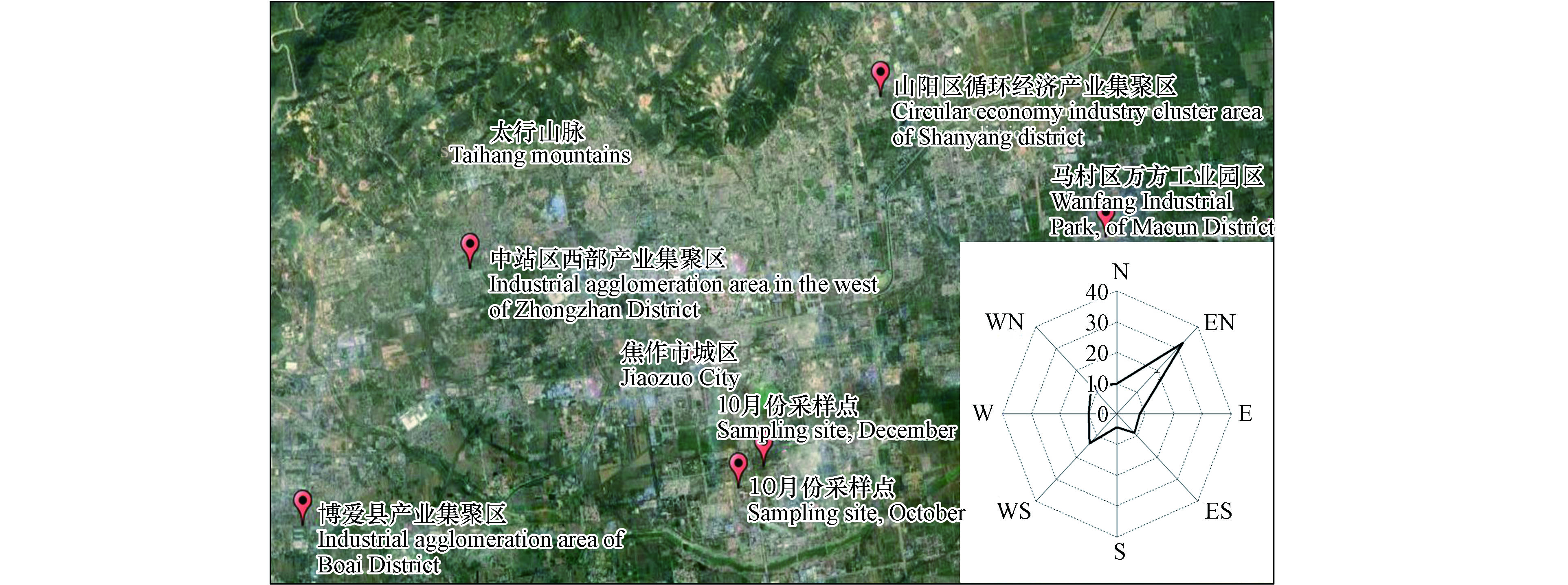
 下载:
下载:
